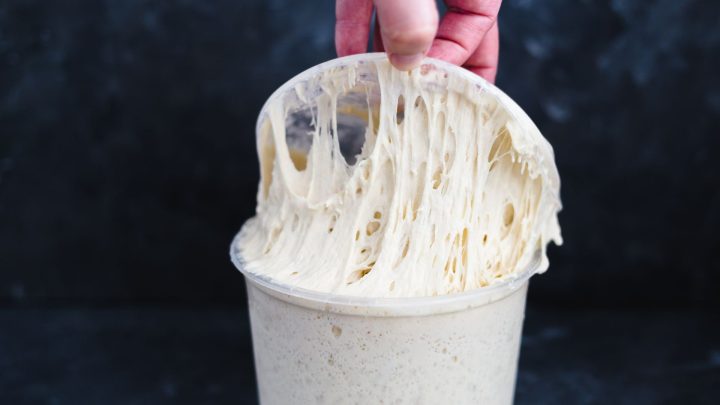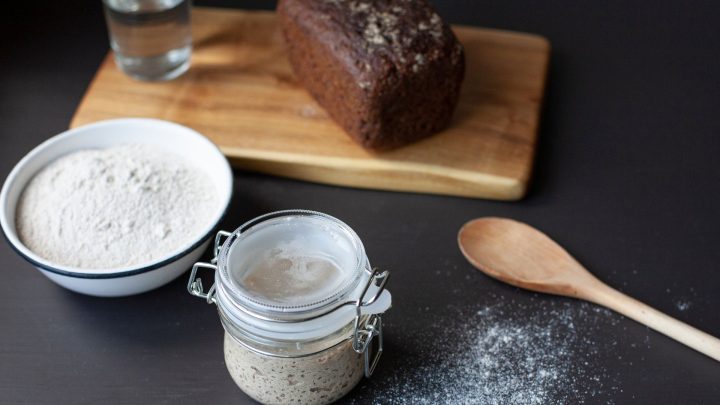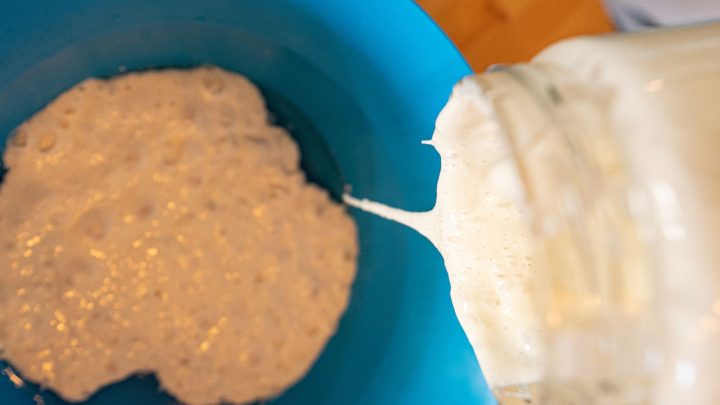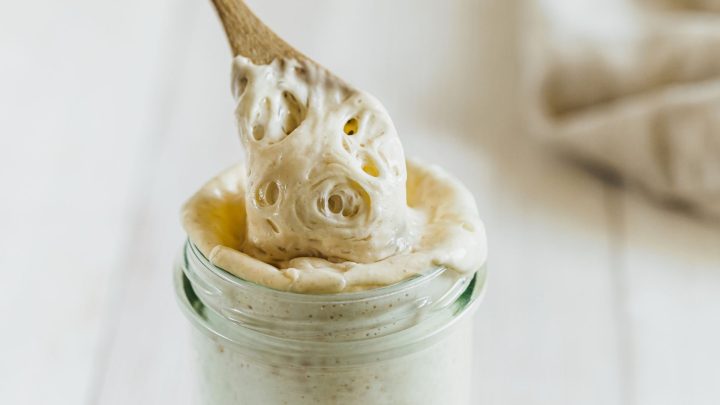When baking sourdough bread, you will find that the recipe calls for a starter, as you would expect. However some recipes may refer to the starter as a levain – a foreign phrase for some. If you’re wondering whether there is a difference between a starter and levain, then you’re not alone. The words are often used interchangeably, but they actually have distinct meanings. And if you’re going to be baking sourdough bread, then it’s important to know the difference! Here’s a brief overview of both terms, so read on and don’t get discouraged by all the baking jargon.

Table of Contents
- Levain vs Starter
- What is Levain?
- How to Make Levain
- What is a Sourdough Starter?
- How to Make a Starter
- Usage in Baking
- Flavor Profiles
- What is a Preferment?
- So, Levain or Sourdough Starter?
- Levain vs Starter FAQs
Levain vs Starter
Levain and sourdough starter are exactly the same thing, with both referring to a portion of a starter that has recently been fed and is ready to be used in a recipe.
The difference between them relies in how they are used.
Levain refers to the portion of a starter that is incorporated into bread dough. While sourdough starter refers to the portion of a starter that remains unused after being incorporated into bread dough.
It’s not uncommon for many bakers to use both terms interchangeably. But if you want to know what sets these two apart, here are some things you should know about them:
Levain refers to a portion of a starter that has been recently fed and ready to be used in a recipe. The starter may have been fed once or several times within a short period of time. A small portion of levain can be added directly into the dough. Or it can be used as part of an overnight refreshment process that will increase its acidity for an improved flavor development during fermentation.
Additionally, the portion of a starter used in bread is considered levain. However, only those portions saved from previous feedings will become new starters, or mothers. The remaining portion of old culture can be discarded after using all its nutrients for leavening purposes. Throwing out old cultures ensures that you’ll achieve consistent results each time you bake with your own particular strain.

What is Levain?
Essentially, levain is a type of sourdough starter, made from wild yeast and bacteria that thrive in your kitchen, feeding off the flour and water in your batter. If you can get this process going, it will produce a stable yeast colony that will last for years, if not forever.
You’ll know it’s working when your levain starts to bubble or ferment, regularly, all on its own, meaning that you don’t have to feed it! All you need to do is add flour and water to make bread with this starter: no commercial yeast necessary.
Levain is a leavening agent made from flour and water, used for baking bread. It’s a larger, younger version of your sourdough starter.
In other words, you’re taking a small part of your starter and feeding it with a larger volume of flour and water.
What is Levain Used for?
Levain is a type of sourdough starter that you can use to make bread. It’s a bit distinct from other starters because it contains flour and water, as opposed to just flour.
A levain is also known as a starter, which is basically a mixture of yeast and flour that has been left out for several hours so that it can ferment and form bubbles of gas (carbon dioxide).
Once this happens, you’ve got yourself some good and useful bacteria. The bacteria in your sourdough creates acidity, which will assist with the overall sourness of the loaf. This also helps break down the gluten in the dough so it becomes more pliable. Moreover, resulting in lighter breads with better structure than those made only with commercial yeast. This is because they have less gluten which makes them easier to digest!
Why do we Use Levain?
Levain is a French word that generally means “sourdough starter”. It’s a mixture of flour and water, which you feed with equal parts flour and water every day. This will promote the growth of beneficial bacteria and yeast.
You’d use this starter when making sourdough bread. But you can also bake with it alone, in place of commercial yeast. One reason levain works well for leavening bread is because its fermentation process increases acidity; this helps break down gluten proteins into smaller pieces, making them easier to digest.
For instance, if you have trouble digesting wheat products because they’re difficult to break down due to the proteins in them, using a levain – a wild culture that has been fermented over time – is an excellent alternative!

If you don’t want to use your sourdough starter directly in your dough, then a levain will take its place.
Levain can be created in whatever size and flavor the baker desires, it’s less acidic and lighter in flavor than your actual starter, because its fresher.
How to Make Levain
To whip up a levain, you’ll need just three simple ingredients: flour, water, and a bit of your mature sourdough starter. It’s like assembling a tiny bread-making squad!
For flour, stick with what you know. If your starter’s been thriving on all-purpose, that’s your go-to. Feeling adventurous? Try whole wheat or rye for a flavor twist. As for water, tap’s fine unless yours tastes like a swimming pool – then opt for filtered.
Mixing It Up
In a clean bowl, combine:
- 1 tablespoon of active sourdough starter
- 50 grams of flour
- 50 grams of lukewarm water
Mix until you’ve got a thick, pancake-batter consistency. No lumps allowed – we’re not making oatmeal here!
The Waiting Game
Cover your bowl with a clean kitchen towel and let it sit at room temperature. Your kitchen counter’s perfect, just keep it away from drafts or that weird spot that’s always oddly cold.
Your levain needs about 8-12 hours.
Signs of Life
How do you know when your levain’s ready? Look for these telltale signs:
- It’s doubled in size (overachievers might even triple)
- You see bubbles throughout – think bubble wrap, but tastier
- It smells pleasantly sour and yeasty
If you’re still unsure, try the float test. Drop a small spoonful in water – if it floats, you’re golden!
Pro Tips
- Use the same ratios each time for predictable results.
- Temperature matters. Warmer rooms speed things up, cooler ones slow it down.
- Don’t stress if it’s not perfect the first time. Levain-making is part science, part art, and a dash of kitchen witchcraft.
What is a Sourdough Starter?
Sourdough starter is a stable mixture of beneficial bacteria and wild yeast that’s continuously maintained, and is used to leaven and flavor the dough. It’s a combination of yeast and bacteria, that can continue to provide for countless loaves, when properly maintained.
The term “starter” refers to the starter culture itself which is typically a blend of flour, water, salt and naturally occurring yeasts.
Sourdough starters are never used entirely. Instead some of it is extracted from the main bulk to mix directly into the dough, with some kept aside as ‘mother’ or ‘levain’ to keep the bacteria thriving in their own separate bowl within your kitchen pantry. For tips on storing starter, read more on our blog.
Struggling to achieve the perfect sourdough starter consistency? You can also check out our blog: How to Make the Best Sourdough Starter Consistency.
How to Make a Starter
Making a sourdough starter is simpler than you might think. You’ll need just two ingredients: flour and water. That’s it! But don’t let this simplicity fool you – there’s a whole world of fermentation magic waiting to happen.
For flour, I’d recommend starting with whole wheat. It’s packed with wild yeast and bacteria, giving your starter a headstart in life. As for water, filtered is best, but if your tap water tastes good, it’ll work just fine.
The Step-by-Step Process
- Mix equal parts flour and water in a clean jar. I usually start with 50 grams of each.
- Cover the jar with a cloth or loosely with a lid. Your starter needs to breathe!
- Let it sit at room temperature for 24 hours.
- The next day, discard half the mixture and feed it with equal parts flour and water again.
- Repeat this process daily for about 5-7 days.
Nurturing Your Starter
You might not see much action for the first few days, but don’t lose heart! By day 3 or 4, you should start noticing some bubbles and a slightly sour smell. That’s your cue that fermentation is kicking in.
Keep feeding your starter daily until it reliably doubles in size within 4-8 hours after feeding. At this point, you’ve got yourself a mature starter ready for baking!
Troubleshooting Tips
If your starter seems sluggish, try using rye flour for a feeding or two. It’s like a superfood for starters! Also, remember that temperature plays a crucial role. A warm spot (around 70-80°F) will speed up fermentation, while cooler temps will slow it down.
Don’t stress if you see a layer of liquid on top – that’s just “hooch,” a sign your starter is hungry. Pour it off or stir it in before feeding.

Usage in Baking
Incorporating Levain in Recipes
Use your levain when it’s at its peak – usually 4-8 hours after feeding, depending on your kitchen’s temperature. At this point, it should be bubbly, have a slightly domed surface, and smell pleasantly sour.
For a basic sourdough loaf, typically use about 15-20% levain in relation to your total flour weight. For a recipe using 1000g of flour, you’d incorporate 150-200g of levain. This provides your dough with sufficient lift without introducing excessive acidity.
Baking with Sourdough Starter
A well-maintained sourdough starter is a consistent resource for baking. Each time you bake, use a portion of your starter and then feed the remainder to maintain its vitality. Unlike levain, which is prepared specifically for a bake, your starter is generally ready for use (assuming regular feeding).
When using starter in a recipe, you’ll often need to adjust the hydration of your dough. Since starters are typically kept at 100% hydration (equal parts flour and water), they’ll add more moisture to your dough than commercial yeast would.
Flavor Profiles
The choice between using levain or starter in your sourdough bread significantly impacts the final flavor. Each option brings unique characteristics to your loaf, affecting both taste and texture.
Levain: Subtle Complexity
Levain typically produces a milder flavor profile in your bread:
- Less pronounced tanginess
- A slight sweetness in the background
- Softer crumb texture
The more gentle flavor of levain results from its shorter fermentation period. This briefer fermentation time leads to fewer acidic compounds developing in the dough.
Starter: Bold Flavors
A mature sourdough starter, in contrast, creates a more intense flavor experience:
- Stronger sour notes (characteristic of classic San Francisco sourdough)
- More complex, layered flavor profile
- Chewier texture and crispier crust
Mature starters have undergone longer fermentation, allowing for the development of a wider range of flavor compounds. This extended process results in a more pronounced taste.
Fermentation’s Role in Flavor Development
The key factor in these flavor differences is fermentation duration. As dough ferments, it becomes more acidic. Levain, being younger, hasn’t had as much time to develop strong acidic notes. Mature starters have fermented for longer periods, creating a broader spectrum of flavors.
Both levain and starter have their place in sourdough baking. The choice between them depends on your preferred flavor intensity and bread characteristics. Experimenting with both options can help you discover which best suits your taste preferences.
What is a Preferment?
By now you’re probably aware of the fact that both sourdough starter and levain are preferments. With both starters using a mixture of flour and water. These are then left to ferment before being combined into your final dough.
A preferment is any mixture that is left to ferment before being used in bread making. This can be as simple as flour and water. Or more complex with additional ingredients such as milk, sugar, butter and/or eggs.
The extra fermentation time contributes additional by-products of fermentation to your dough in the form of organic acids and alcohols. This equals flavor!
Both the mother starter and levain fall under this category as well. This is because they are mixed ahead of time, and left to ferment so that they’re ready when needed later on in the process – typically when creating breads with more than one rise.
They also contribute to the flavor. But they do not contain any commercial yeast like instant dry yeast does. This means they need to be stored in a refrigerator, awaiting it’s next calling.
So, Levain or Sourdough Starter?
Since levain is part of the sourdough starter and added to the final product to make your terrific leavened dough, one cannot work without the other. So when making sourdough bread, you’ll need both levain and sourdough starter to achieve the loaf you desire.
Levain vs Starter FAQs
Is Levain the Same as Starter?
Levain is a part of your sourdough starter, and is obtained using a fresh mixture of flour, water along with some ripe starter.
Is Levain the Same as Sourdough?
Levain and sourdough starter are typically the same thing, as they are both made up of fermented flour and water, which contains wild yeast and bacteria that is used to leaven bread.
How do You Make Levain from Starter?
Begin by weighing out the sourdough starter into a large bowl, add the water and flour to the bowl. Cover the bowl with a tea towel and let the sourdough levain sit at room temperature for 8 hours, and overnight. The next day the levain should be airy and doubled in size.
Can You Leave Levain Overnight?
Before you plan to start your sourdough starter recipe, make the levain the night before, and allow it to become active and bubbly before using it.






